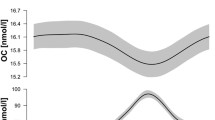Abstract
Seasonal and interindividual differences in food availability and illnesses cause variations in growth, including bone growth, in children in developing countries. We investigated seasonal differences in biochemical (serum) markers of bone metabolism and relationships between these markers (procollagen type I N propeptide [P1NP], serum C-terminal telopeptide of type 1 collagen [S-CTX]) and serum markers of inflammation (α1- antichymotrypsin [ACT], C-reactive protein [CRP], sialic acid) in prepubertal Gambian boys. Three seasonal time points were chosen: August, mid-rainy season; October, late rainy season (both are associated with decreased food supply, increased prevalence of infection, reduced weight gain, and stunting); and April, late dry season, when environmental conditions are better and rates of weight gain are higher. The prevalence of raised inflammatory markers was high: 29% of ACT values >0.40 g/L in August, 42% >0.40 g/L in October, and 18% >0.40 g/L in April. Of CRP values, 92–96% were >0.47 mg/L and 30%, 46%, and 18% were >3.95 mg/L in August, October, and April, respectively. Also, 42–52% of sialic acid values were >648 mg/L. Of the bone markers, S-CTX exhibited the highest values in August; P1NP did not vary with season. Inverse relationships between each bone marker and the acute phase markers occurred, with the strongest relationships between P1NP and ACT or sialic acid. We conclude that bone collagen synthesis and turnover are reduced during inflammation in rural Gambian boys. Biochemical indices can provide powerful, single-time point evidence of infection and growth-faltering episodes.

Similar content being viewed by others
References
Singh J, Prentice AM, Diaz E, Coward WA, Ashford J, Sawyer M, Whitehead RG (1989) Energy expenditure of Gambian women during peak agricultural activity measured by the doubly-labelled water method. Br J Nutr 62:315–329
Panter-Brick C, Lunn PG, Baker R, Todd A (2001) Elevated acute-phase protein in stunted Nepali children reporting low morbidity: different rural and urban profiles. Br J Nutr 85:125–131
Rooney M, Davies UM, Reeve J, Preece M, Ansell BM, Woo PM (2000) Bone mineral content and bone mineral metabolism: changes after growth hormone treatment in juvenile chronic arthritis. J Rheumatol 27:1073–1081
Dibba BJ, Prentice A, Ceesay M, Darboe S, Stirling DM, Cole TJ, Poskitt EM (2000) Effect of calcium supplementation on bone mineral accretion in Gambian children accustomed to a low-calcium diet. Am J Clin Nutr 71:544–549
Dibba BJ (1999) Calcium requirements for bone growth and development in Gambian children. In: MRC Human Nutrition Research. Open University, Milton Keynes
Aspray TJ, Yan L, Prentice A (2005) Parathyroid hormone and rates of bone formation are raised in perimenopausal rural Gambian women. Bone 36:710–720
Doherty CP, Crofton PM, Sarkar MA, Wade JC, Kelnar CJ, Elminger MW, Ranke MB, Cutting WA (2002) Malnutrition, zinc supplementation and catch-up growth: changes in insulin-like growth factor 1, its binding proteins, bone formation and collagen turnover. Clin Endocrinol 57:391–399
Gregory J, Lowe S, Bates C, Prentice A, Jackson L, Smithers G, Wenlock R, Farron M (2000) National Diet and Nutrition Survey: Young People Aged 4 to 18 Years. Volume 1: Report of the Diet and Nutrition Survey. Stationery Office, London
Cook DG, Mendall MA, Whincup PH, Carey IM, Ballam L, Morris JE, Miller GJ, Strachan DP (2000) C-reactive protein concentration in children: relationship to adiposity and other cardiovascular risk factors. Atherosclerosis 149:139–150
Sillanaukee P, Ponnio M, Jaaskelainen IP (1999) Occurrence of sialic acids in healthy humans and different disorders. Eur J Clin Invest 29:413–425
Munday K, Fulford A, Bates CJ (2005) Vitamin C status and collagen cross-link ratios in Gambian children. Br J Nutr 93:501–507
Suguhara K, Sugimoto K, Nomura O, Usui T (1980) Enzymatic assay of serum sialic acid. Clin Chim Acta 108:493–498
Cole TJ (1990) The LMS method for constructing normalized growth standards. Eur J Clin Nutr 44:45–60
Seibel MJ (2000) Molecular markers of bone turnover: biochemical, technical and analytical aspects. Osteoporos Int 6(suppl):S18–S29
Seibel MJ (2002) Nutrition and molecular markers of bone remodelling. Curr Opin Clin Nutr Metab Care 5:525–531
Robins SP (1994) Biochemical markers for assessing skeletal growth. Eur J Clin Nutr 48(suppl 1):S199–S209
Ginty F, Cavadini C, Michaud PA, Burckhardt P, Baumgartner M, Mishra GD, Barclay DV (2004) Effects of usual nutrient intake and vitamin D status on markers of bone turnover in Swiss adolescents. Eur J Clin Nutr 58:1257–1265
Whicher JT, Dieppe PA (1985) Acute phase proteins. Clin Immunol Allergy 5:425–426
Thompson D, Milford-Ward A, Whicher JT (1992) The value of acute-phase protein measurements in clinical practice. Ann Clin Biochem 29:123–131
Wilkins J, Gallimore JR, Moore EG, Pepys MB (1998) Rapid automated high sensitivity enzyme immunoassay of C-reactive protein. Clin Chem 44:1358–1361
Kundu SK, Diego I, Osovitz S, Marcus DM (1985) Glycosphingolipids of human plasma. Arch Biochem Biophys 238:388–400
Stefenelli N, Klotz H, Engel A, Bauer P (1985) Serum sialic acid in malignant tumors, bacterial infections and chronic liver diseases. J Cancer Res Clin Oncol 109:55–59
Lunn PG (2000) The impact of infection and nutrition on gut function and growth in childhood. Proc Nutr Soc 59:147–154
Duan Y, Wang XF, Seeman E (2004) Structural and biomechanical basis of sexual dimorphism in femoral neck fragility has its origins in growth and aging. J Bone Miner Res 18:1766–1774
Bradney M, Karlsson MK, Duan Y, Stuckey S, Bass S, Seeman E (2000) Heterogeneity in the growth of the axial and appendicular skeleton in boys: implications for the pathogenesis of bone fragility in men. J Bone Miner Res 15:1871–1878
Aspray TJ, Prentice A, Sawo Y, Darboe S, Day K, Paul AA, Fairweather-Tait S (1996) Low bone mineral content is common but osteoporotic fractures are rare in elderly rural Gambian women. J Bone Miner Res 11:1019–1025
Acknowledgment
The authors are indebted to the late Dr. Bakary Dibba for his generous assistance with the study fieldwork.
Author information
Authors and Affiliations
Corresponding author
Rights and permissions
About this article
Cite this article
Munday, K., Ginty, F., Fulford, A. et al. Relationships between Biochemical Bone Turnover Markers, Season, and Inflammatory Status Indices in Prepubertal Gambian Boys. Calcif Tissue Int 79, 15–21 (2006). https://doi.org/10.1007/s00223-005-0276-4
Received:
Accepted:
Published:
Issue Date:
DOI: https://doi.org/10.1007/s00223-005-0276-4



